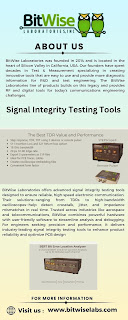S-Parameter Measurements with a TDR – Bitwise Laboratories
S-parameter measurements with a TDR are
crucial for evaluating the electrical performance of transmission lines,
connectors, and other high-frequency components. At Bitwise Laboratories, we utilize Time Domain Reflectometry (TDR) to
accurately measure S-parameters,
providing valuable insights into signal integrity, impedance mismatches, and
transmission line characteristics.
Scattering parameters, or S-parameters, describe how
electrical signals behave in a multi-port network. These measurements help
engineers analyze how signals are transmitted, reflected, and absorbed in a
system. Traditional S-parameter
measurements are typically performed using a Vector Network Analyzer
(VNA), but TDR-based methods
offer a time-domain alternative, enabling high-resolution signal analysis.
A TDR
works by sending a fast-rising edge signal into a device under test (DUT) and
measuring the reflected and transmitted signals. By applying Fourier Transform techniques, the
time-domain data can be converted into frequency-domain S-parameters, allowing for a
comprehensive evaluation of the DUT's performance.
Advantages of Using TDR
for S-Parameter Measurements
1.
High-Resolution Impedance Analysis
S-parameter measurements with a TDR provide
precise insights into impedance discontinuities, transmission line losses, and
connector performance. Unlike frequency-domain measurements, TDR allows for
time-gated analysis, isolating specific sections of the DUT for better
accuracy.
2.
Fast and Non-Destructive Testing
TDR-based S-parameter measurements
are quick and do not require extensive calibration procedures like traditional
VNA methods. This makes TDR ideal for in-situ testing, troubleshooting, and
quality control in manufacturing environments.
3.
Wideband Analysis
With modern TDR systems, engineers can measure S-parameters across a broad frequency range,
making it an effective tool for characterizing high-speed digital and RF
components.
How Bitwise Laboratories
Conducts S-Parameter Measurements
At Bitwise
Laboratories, we use state-of-the-art TDR equipment to ensure accurate and
repeatable S-parameter measurements.
Our process includes:
- Calibrated TDR Setup: We use high-performance probes and calibration
standards to minimize errors.
- Time-Domain Data Acquisition: A high-speed pulse is transmitted into the DUT,
and the reflected signals are captured.
- Fourier Transform Analysis: We convert the time-domain reflections into
frequency-domain S-parameters, providing a
complete picture of the DUT’s electrical behavior.
- Advanced Data Interpretation: Our experts analyze the results to detect
impedance mismatches, insertion loss, and signal reflections, ensuring
optimal circuit design.
Applications
of TDR-Based S-Parameter Measurements
- High-Speed PCB and Interconnect Testing
- RF and Microwave Component Characterization
- Cable and Connector Performance Analysis
- Semiconductor and IC Package Evaluation
Conclusion
Using S-parameter measurements with a TDR, engineers
can effectively analyze signal behavior, optimize circuit performance, and
diagnose potential issues in high-frequency applications. At Bitwise Laboratories, we
provide industry-leading TDR
measurement services
to help businesses ensure reliable signal integrity and electrical
performance.
For more information
Visit us : https://bitwiselabs.com/




Comments
Post a Comment